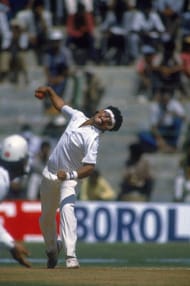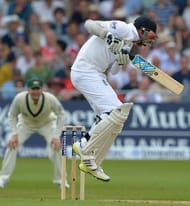The coin toss might soon become a lost cricketing traditionCricket is a sport which has so many quirks and traditions that it puts all other sports to shame. Just think about the MCC members wearing that eye-catching suit of red and yellow, or about the tradition of taking a tea break, and you can see why.The most charming of all traditions is that cricketers wear cricket ‘whites’ during Test matches. This seems so out-of-place in a world where other sportsmen wear jerseys of every conceivable colour (other than at the lawns of Wimbledon), but this adds to the beauty of Test cricket.The coin toss is another tradition that has been around seemingly forever in cricket. So it was with a lot of incredulity that I read, earlier this year, about the ECB’s decision to scrap the toss for next season's County Championship.So now, before we dive into this list of traditions which have disappeared completely or almost completely in cricket, let's take a minute and say a little prayer that the toss doesn't make it to a list such as this one in the future.
#1 The Rest Day

A day in the middle of a Test where there is no play? No, not because play was abandoned, but because that was the way things were done. This is unimaginable in these days of cramped cricket tours, where there is often just about time to fit in one tour game.
But the rest day was a regular feature of Test Cricket well into the 1980s. The teams would play 2-3 days of cricket, then take a day off, and get back to cricket the following day. In England, there was usually no play on Sundays (initially for religious reasons), and the players would go out golfing or relax with a book in hand on the day.
But it became clear that there was an advantage to playing on Sundays, when most people were free to attend matches, and Sunday play became a regular event. And the rest day itself eventually disappeared altogether.
Or at least the official rest day in the middle of a Test disappeared. Now there is very often an unofficial rest day or two with a number of recent matches finishing in 3-4 days.
It is safe to say that this is one tradition that neither players nor fans miss, as it disrupts the flow of the game unnecessarily. We have rain to disrupt the game’s flow, so why have a rest day too?
#2 The Pongal Test

The showpiece event of the Australian cricket summer is the Boxing Day Test at Melbourne, which starts every year on December 26. This tradition has been going strong for 35 years, having officially started in 1980 (there was a match which started on Boxing Day in 1974, but this wasn’t a regular event at the time).
India had its own tradition of a Test played during the Pongal period (in mid-January) in Chennai. Like in Australia where people are on vacation during the Christmas period, Pongal is a time when Chennai is on vacation. What better time to play a Test than when schools, colleges and offices have 2-3 days of holidays?
Interestingly, of the 9 Tests that have ever been played in Chennai during Pongal, all bar one have been against England or the West Indies. Who did India play in the other Test? The old enemy of course, Pakistan!
However, the Pongal Test has, sadly, become just a memory now. The last Test match played during Pongal in Chennai was as far back as 1988. This was also Narendra Hirwani’s sensational debut match against the West Indies, in which he took a scarcely believable 16 wickets to lead India to victory.
Now, with the increase in the number of venues in which Test Cricket is played in India, it has seemingly become very difficult to even schedule Test matches at the M.A. Chidambaram stadium (there has been only one Test there since 2008), let alone schedule them during Pongal.
This is a real pity, since this is one of the most historic grounds in India, and January is a time when the weather is pleasant in Chennai. And more than anything, holding an annual Pongal Test would be a chance to maintain a tradition, much like Australia has carried on its tradition of the Boxing Day Test.
#3 Fast Bowlers Not Bowling Bouncers To Tail-enders

Cricket has always been called the ‘Gentleman’s game’. This reputation was fair at one time, when you consider that fast bowlers never pitched the ball short to tail-enders.
This was in the days where there were no helmets, and very little protection. When you add in the fact that most tail-enders at the time could not bat to save their lives, you can see why pacers didn't want to run the risk of causing serious injury to them.
The situation is very different now, and fast bowlers have no qualms about bouncing their counterparts in the opposition. Thanks to the helmet, chest guards and the improved batting ability of bowlers, the quicks now consider tail-enders fair play for the short ball.
But when you think about Phil Hughes, it makes you wonder. If an accomplished batsman like Hughes could actually be killed because he missed a bouncer, what could happen to these technically inferior tail-enders who often get into strange positions to avoid/play the short ball?
So let’s all hope that this tradition will return – not bouncing tail-enders is not only the gentlemanly thing to do, it is also the sensible thing to do. Otherwise, we might have another tragedy on our hands.
#4 Umpire Asking Outfielder if it is a Boundary

The Western Australian Cricket Association’s Traditions and Etiquette of Cricket says – ‘Always signal to the umpire when the ball reaches the boundary’.
Trust is a wonderful thing and is in short supply in these days of decision reviews and third umpires. Back in the old days, umpires would ask a fieldsman on the boundary if the ball had crossed over the rope for six, or if he had pulled the ball back before it crossed the boundary line.
The fieldsman would be expected to be honest, and tell the umpire exactly what he felt or saw. The umpire would take the fielder's word, and make the appropriate boundary signal (or not). One of the most wonderful sights in cricket is watching the fielders of old signal a six to the umpire instead of a four. They could easily have got away with saying it was a four.
These days, technology is so prevalent that there is almost no hope of umpires asking the fielders if the ball crossed the boundary. The umpires go upstairs for everything, so their thinking is: why not make sure about these boundary decisions too by going to the third umpire?
One big advantage of asking the fielders to make the decision is that it saves a lot of time. But it is difficult to trust everyone, and sometimes the fielders themselves are not sure if the ball crossed the boundary. So, it is difficult to see this 'tradition' returning.
#5 Applauding a Batsman when he gets to a Century

When you see highlights of matches in the 1970s and 80s, you can’t help but notice that whenever a batsman reaches a century (or another milestone), the fielding team applauds him (and very often, the crowd gives him a standing ovation even if he is from the ‘away team’).
You also see a lot of instances in which the fielding team comes over and shakes a batsman’s hand when he has been dismissed after making a century.
Of course, there are times even now when good performances are applauded by the opposition, but the game has got so competitive that you are pleasantly surprised when it happens.
#6 Teams Get Together after a Day\'s Play

England’s Stuart Broad clearly described the difference between two generations when he commented that while the teams have a beer together after a series these days, the England team in which his father Chris played had a drink with the opposition every day.
Back in Chris Broad’s time (the 80s), teams played to win, but were generally no longer rivals after the day’s play. They religiously shared a drink together in the dressing room, regardless of the match situation.
The famous 2005 Ashes was a series in which both teams drank together after every match, but this was an exception rather than the norm.
But recently, Alastair Cook’s England invited New Zealand to their dressing room for a drink after the First Test of their series, and went to the New Zealand dressing room after the second Test, prompting hopes of a revival of this tradition.
However, in a move that dashed such hopes to the ground, Australia declined Cook’s invitation for a drink after they lost the First Test of the Ashes, which happened immediately after the NZ series.
Follow IPL Auction 2025 Live Updates, News & Biddings at Sportskeeda. Get the fastest updates on Mega-Auction and cricket news
